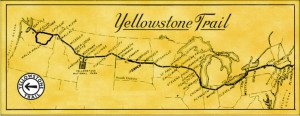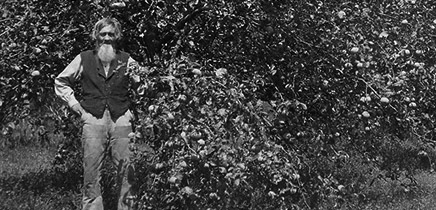The Yellowstone Trail began through frustration. At a time when horse and wagons were being phased out, and more and more cars were on the road, there was not yet government control of roads. Roads that those on horseback or wagon could travel with ease, stopped cars with ruts, mires, and potholes. Very few of these roads connected to others. They might connect Point A to Point B, but that was all. By 1912, there were 356,000 cars on the road, by 1915 sales neared a million.
The Yellowstone Trail’s claim to fame is not being the first road in many places, but being the first “good” road, the first road designed for travel by car from east coast to west coast. Hence, the motto of the road: “a good road from Plymouth Rock to Puget Sound”. Inspired by old walking/trade trails like the Santa Fe Trail, and tired of his car getting stuck in the mud between Ipswich and Aberdeen, South Dakota, Joe Parmley was inspired to create ‘good’ roads that connected to one another. A local homesteader, newspaperman, Superintendent, and State and County Officer, he at first thought it should be the responsibility of the state and federal governments. At the time, there was no tax or legislation for road building or road maintenance, and no transportation departments. The only road funding at this time (1912, 1916, and 1921) was for the creation of post roads for Rural Free Delivery. Parmley was laughed out of the South Dakota legislature for suggesting such a thing.
Frustrated by the lack of an auto-friendly infrastructure, Parmley decided to start a grass-roots movement, teaming with local county/township governments or organizations to meet his goal. The goal was to choose the best roads within the township or county, connect those to the most promising or well-kept roads in the next county, and eventually create one road with one name covering a large distance.
To promote and advocate for this idea, Joe Parmley teamed with others of a like mind to create the Twin Cities-Aberdeen-Yellowstone Park Trail Association on October 9, 1912. This organization collected dues to pay for advertising and promotion, and maps of the trail. Member counties paid $50, individuals paid $1, and cities or auto club groups paid based on their number of residents or members. The cities, townships or counties, and not the Association, paid for the roads within the trail. In 1915, at the annual meeting, the group’s name was shortened to the Yellowstone Trail Association, and the motto “a good road from Plymouth Rock to Puget Sound” was adopted after being popularized in the press. As the Trail expanded, it was marked by stones painted yellow, yellow signposts, or yellow arrows.
As the Trail passed through Minnesota, it left its mark in Carver County. On May 2, 1916, County Commissioners agreed to pay $4,000 for improvements along the Trail, to be assessed to each city based on how much of the Trail they had. The breakdown follows: Chanhassen, 3 ½ miles; Laketown, 7 miles; Waconia, 7 miles; Benton, ½ mile; and Young America, 7 miles. Financially, Victoria gave $250, Young America gave $750, Norwood gave $1,000 and Waconia gave $1,500. In the twenty-first century, the Trail in Waconia is Highways 5 and 212. Ruts from the Trail are still visible- park at the Waconia Event Center and walk east, looking along the south side of Highway 5, you may see the ruts or yellow signs denoting where the trail once passed.
As the Trail expanded, promotional stunts occurred to boost interest and acclaim. The first occurred on June 15, 1915, after the trail connected Chicago to Seattle. A relay of twenty-one cars was put together to carry a message from Chicago’s Mayor Thompson to Seattle’s Mayor Gill. Cars would go in shifts, like a relay race. The goal was to complete the 2,445 miles in 100 hours. The relay finished early at 97 hours. In 1916, when the Trail reached the East Coast at Plymouth Rock, a new relay was organized, pairing the Army with civilian drivers. Sixty-four cars (with 126 back-up or emergency cars) carried an Army message over 3,673 miles in 121 hours. As there relays passed through towns, residents were warned to use caution around the cars traveling at high speeds.
The Yellowstone Trail reached its peak years in the 1920s, with advances in road funding and tourist bureaus along the route encouraging its use by tourists. The Trail was touted as the “great Northwest route”, “the best route to the playground of the three national parks (Yellowstone, Glacier, and Mt. Rainier)”, and the “scenic route with no deserts”. This was the beginning of the end. The government adopted legislation on November 11, 1926 to begin marking highways by numbers, breaking the Trail down into smaller roads. In the twenty-first century, there is a resurgence of interest in the Yellowstone Trail, with historical markers across the country, books, and tourist maps now highlighting this historic trail.
For more information, visit www.yellowstonetrail.org

“Highway Enthusiasts Confer with Commissioner.” Waconia Patriot, May 5, 1916.
“May Lose Yellowstone Trail.” Weekly Valley Herald, August 1, 1929.
“May Organize Yellow Trail Auto Club.” Waconia Patriot, May 12, 1916.
Northwest History Course. “Yellowstone Trail”. Accessed June 17, 2014. http://www.nwhistorycourse.org/ttcourse/Year2/unit3/week11/yellowstone.html
“Notice to Contractors.” Waconia Patriot, May 30, 1918.
Petersen Biorn, Wendy. “Yellowstone Trail: Remembering the Good Road”. Chaska Herald, September 2, 2012.
Ridge, Alice A. and John William. Introducing the Yellowstone Trail: A Good Road from Plymouth Rock to Puget Sound, 1912-1930. Altoona, WI: Yellowstone Trail Publishers, 2000.
Ridge, Alice A. and John William. On the Yellowstone Trail: A Reproduction of the First Year Book of the Twin Cities-Aberdeen-Yellowstone Park Trail Association (The Yellowstone Trail Association), 1914. Altoona, WI: Yellowstone Trail Publishers, 2003.
“Surveying Yellowstone Trail Route.” Waconia Patriot, May 3, 1917.
The Yellowstone Trail. “Yellowstone Trail Information”. Accessed June 17, 2014. http://www.yellowstonetrail.org/id2.htm
“The Yellowstone Trail Association of Minnesota- Road Enthusiasts Want Yellow Trail to Receive Attention.” Waconia Patriot, August 31, 1916.
“U.S. Intends to Boulevard Yellowstone Trail.” Waconia Patriot, March 8, 1917.
“Waconia Boosted in Trail Magazine.” Waconia Patriot, May 5, 1916.
“Yellowstone Before 212.” Chanhassen Villager, July 10, 2008.
“Yellowstone Trail Garage.” Waconia Patriot, March 11, 1920.
“Yellowstone Trail has Been Designated as One of $ Military Highways.” Waconia Patriot, July 19, 1917.


